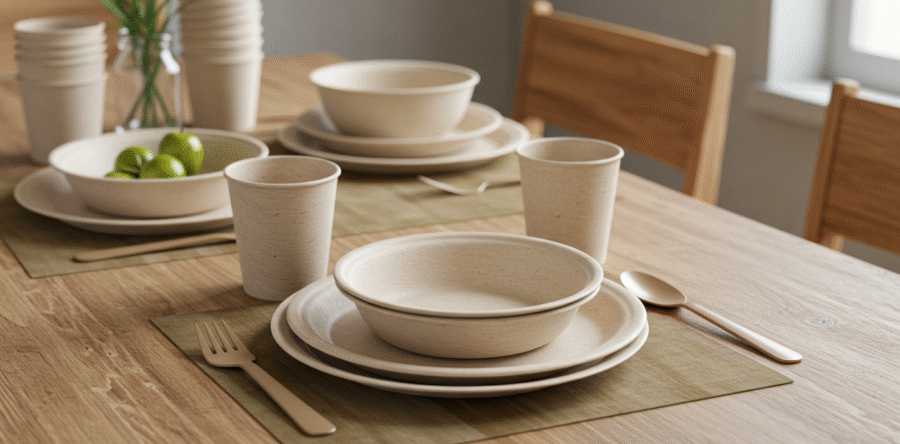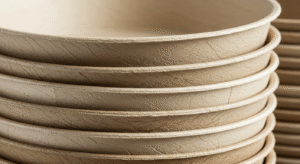How to Care for Your Dinnerware

Eco-friendly dinnerware is currently the trend now. It is stylish and sustainable, and it does not create a carbon footprint after each meal. If you have recently transitioned to them at home, it is crucial to maintain your compostable or biodegradable dinnerware in excellent condition.
Here is your comprehensive guide on how to maintain your eco-friendly dinnerware without causing stress or creating a mess.

Why Proper Care Matters
Eco-friendly dinnerware is made from natural materials like molded pulp, sugarcane bagasse, wheat straw, bamboo, or palm leaves. These materials are biodegradable and often compostable, but they’re not as invincible as plastic or ceramic.
So yes, while they’re saving the planet one meal at a time, they also need a little TLC to make sure they last through your event (and maybe a few more).
1. Know What You’re Using
Before anything else, figure out what type of eco-dinnerware you have. Is it molded pulp? Palm leaf? Bamboo? Different materials require slightly different care.
- Molded pulp: Strong and sturdy, made from recycled paper. Often used in trays or disposable plates.
- Palm leaf: Great for aesthetics, it can handle hot or cold food but may warp if soaked too long.
- Bagasse (sugarcane): Lightweight, grease-resistant, and microwave-safe (usually).
Knowing what you’re working with is half the battle.
2. Keep It Dry Until Use
Moisture is not a friend to biodegradable materials. If you’re storing plates, bowls, or trays for future use, keep them in a cool, dry place. Humidity can weaken the structure of molded pulp and other plant-based dinnerware over time.
Tip: Store your dinnerware in sealed boxes or airtight containers to protect it from moisture and accidental spills.
3. Avoid Long Soaks
Unlike traditional dishes, eco-friendly options aren’t designed for soaking. If you’re serving liquids or oily foods, they’ll hold up—but don’t leave them out overnight or reuse them for round two at breakfast.
While some molded pulp plates can take the heat and wetness better than others, remember: they’re built to break down over time. Just not mid-meal.
4. Microwave & Oven Use? Check the Label
Some molded pulp dinnerware is microwave- and oven-safe (yes, really), but not all are. Check the packaging or ask your supplier if your plates and trays can handle the heat.
As a rule of thumb:
- Microwave use: 1–2 minutes is usually fine.
- Oven use: Not recommended unless clearly marked as safe.
5. Compost or Trash? Disposal Done Right
Once your eco-friendly dinnerware has done its duty, it deserves a proper send-off. Most molded pulp and biodegradable plates can go in a commercial compost bin. If you’re using certified compostable dinnerware, double-check your local composting guidelines.
No compost bin nearby? Don’t worry—these materials will still break down much faster than plastic in a landfill.
6. For Businesses: Train Your Team
If you run a restaurant, café, or catering business using molded pulp or other sustainable dinnerware, make sure your staff knows how to store and handle it. Even a quick 10-minute briefing can help prevent waste and save money in the long run.
Why It’s Worth the Effort
Eco-friendly dinnerware isn’t just a trend—it’s a step in the right direction. By choosing sustainable options and learning how to care for them properly, you’re not just serving meals—you’re serving the planet too.
Plus, let’s be real—there’s something satisfying about tossing your plate after a meal and knowing it won’t be sitting in a landfill for the next 500 years.
Looking for molded pulp dinnerware that’s durable, sustainable, and ready to ship? Check out our trusted partners at WineShippingBoxes.com for eco-friendly molded pulp products that check every box.




